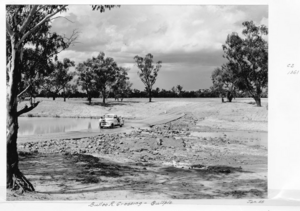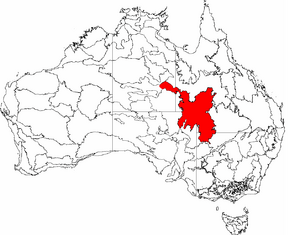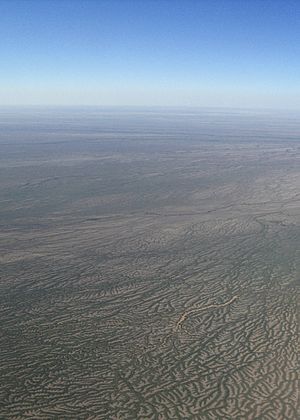Channel Country facts for kids

The Channel Country is a special part of outback Australia. It's mostly in Queensland, but also stretches into South Australia, the Northern Territory, and New South Wales. This area gets its name from the many small, intertwined rivers that crisscross the land. These rivers cover a huge area, about 150,000 square kilometers! The Channel Country sits over the Cooper and Eromanga basins, which are like giant bowls in the Earth. It's also part of the Lake Eyre Basin, where water flows towards Lake Eyre.
Contents
What is the Geography of Channel Country?
The Channel Country is a very dry place with a unique landscape. It has many old floodplains from rivers that only flow sometimes. The main rivers here are the Georgina River, Cooper Creek, and the Diamantina River.
Towns and Landmarks
The most well-known towns in the Channel Country are Birdsville and Windorah. Other small towns include Betoota and Bedourie. You can also find Haddon Corner here, which is where the borders of Queensland, South Australia, and the Northern Territory meet.
This region is also famous for Min Min light sightings. These are mysterious lights that people sometimes see at night. The Channel Country is also home to important bird areas, like Lake Yamma Yamma and the Lake Machattie Area. These places are vital for many bird species.
How Do Rivers Flow in Channel Country?
The rivers in Channel Country don't flow all the time. They only flow when there's a lot of rain in the areas where they start. When this happens, the floodwaters travel towards Lake Eyre in South Australia. However, in most years, the water soaks into the ground or evaporates before it reaches the lake.
One big flood happened in 2010. A huge rain system from an old Cyclone Olga caused an amazing amount of rain. This filled the rivers and brought life to the dry landscape.
How is the Land Used?
The main activity in the Channel Country is cattle grazing. This means raising cattle for meat. In the Queensland part alone, there are between half a million to one million cattle! The towns and large cattle farms (called stations) in this area get their supplies and mail delivered by a special mail plane service. This service, run by West Wing Aviation, also carries passengers.
In 2013, the Queensland Government put rules in place to limit how much water could be taken from the rivers. This was to stop too much cotton growing, which uses a lot of water. They also banned open-cut mining, which digs up the land. However, some underground mining is allowed after new laws were made.
What is a Bioregion?
The Interim Biogeographic Regionalisation for Australia (IBRA) has a special area called the Channel Country Bioregion. This area is even bigger than the Channel Country itself. It includes parts of South Australia, the Northern Territory, and New South Wales, and even the town of Innamincka.
History of Channel Country
Indigenous Australians have lived in the Channel Country for about 20,000 years. More than 25 different tribal groups called this area home. They had a large trade network that went from north to south. They traded things like ochre (a natural pigment) going north, and shells and pituri (a plant used for chewing) moving south. Birdsville was once a very important meeting place for ceremonies and trade.
Early Settlements
In 1872, Innamincka Station was started by Robert Bostock. It grew very large, covering over 15,000 square kilometers. By 1881, it had 8,000 cattle. It was the first cattle station and permanent settlement along Cooper Creek. Other stations were set up around the same time. For example, the Caryapundy station was started in 1872.
Annandale Station was established in 1876. Soon after, other properties like Kaliduwarry and Glengyle Stations were also settled. Pandie Pandie Station, Alton Downs, and Planet Downs were all started in the same year, 1876. Nearby Haddon Downs station was also taken up in 1877. Diamantina Lakes Station also began in 1876.
Birdsville was first known as Diamantina Crossing in 1881. But by 1882, people started calling it Birdsville, and this name became official when the town was formally declared in 1887.
See also
 In Spanish: Channel Country para niños
In Spanish: Channel Country para niños



